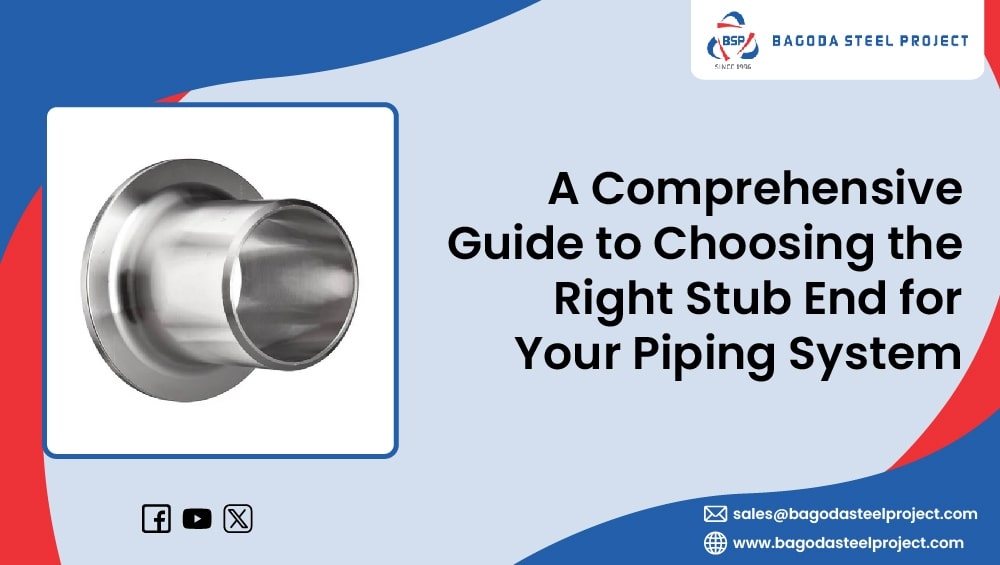A Comprehensive Guide to Choosing the Right Stub End for Your Piping System

A Comprehensive Guide to Choosing the Right Stub End for Your Piping System
When building or preserving a piping system, deciding on the right components is essential to ensure the gadget's sturdiness, efficiency, and capability. Among those additives, Lap Joint Stub Ends play an extensive role in connecting pipes and facilitating the disassembly and reassembly of sections for protection or modifications.
Bagoda Steel Project, a trusted call within the industry, makes a specialty of extremely good Lap Joint Stub Ends and other Pipe Fittings designed to fulfill diverse industrial desires. This manual will assist you in understanding the significance of stub ends, their programs, and how to choose the proper type for your gadget.
What Are Lap Joint Stub Ends?
Lap Joint Stub Ends are a kind of pipe fitting used in conjunction with lap joint flanges. Unlike traditional welded or threaded connections, stub ends offer a removable joint, making them best for pipelines that require frequent renovation or changes.
A stub give up includes two primary parts:
Stub End Body: The short pipe with a flange-like lip, welded to the end of the pipe.
Lap Joint Flange: A loose flange that slides over the stub quit and aligns with another flange for connection.
This assembly allows easy rotation and alignment, making installation and disassembly greater straightforward than traditional connections.
Types of Lap Joint Stub Ends
Short Stub Ends (Type A)
Used with popular lap joint flanges. The face of the stub end is designed for a right fit with the flange.
Long Stub Ends (Type B)
Commonly used in pipeline systems with large pipe sizes or excessive-pressure packages, providing greater electricity and durability.
MSS Stub Ends (Type C)
Manufactured in line with the MSS-SP-forty three fashionable, appropriate for lightweight, low-pressure systems.
Benefits of Using Lap Joint Stub Ends
- Easy Maintenance
Stub ends allow short disassembly of piping structures for cleansing, inspection, or replacement, lowering downtime during preservation.
- Cost-Efficiency
By the use of a mixture of stub ends and lap joint flanges, you may minimize fabric fees, specially in high-fee substances like stainless-steel, as most effective the stub give up requires corrosion resistance.
- Enhanced Alignment
The loose flange design ensures smooth alignment of bolt holes, even in hard set up conditions.
- Reusability
Stub ends can be reused with new flanges, making them a sustainable and cost-effective choice for dynamic structures.
- Versatility
Available in quite a number sizes, substances, and standards, stub ends can be tailor-made to suit various industrial applications.
Applications of Lap Joint Stub Ends
Lap Joint Stub Ends and their corresponding flanges are widely used throughout industries because of their adaptability and reliability:
Oil and Gas
Ideal for offshore and onshore pipelines requiring corrosion resistance and smooth preservation.
Chemical Processing
Used in structures transporting corrosive or dangerous fluids, in which everyday inspection is necessary.
Water Treatment
Common in pipelines carrying water or wastewater, providing flexibility and durability.
Food and Beverage
Suitable for hygienic piping systems in which common cleaning and inspection are important.
Power Plants
Used in excessive-stress and excessive-temperature pipelines, ensuring secure connections and ease of operation.
How to Choose the Right Stub End for Your Piping System
Selecting the best Lap Joint Stub Ends involves numerous concerns to make sure compatibility and performance:
- Material Selection
Choose a stub end material that matches the pipe cloth and is suitable for the operating environment. For instance:
Stainless Steel: Excellent for corrosive environments.
Carbon Steel: Ideal for high-electricity, low-corrosion applications.
Alloy Steel: Suitable for excessive-temperature and excessive-strain systems.
- Pipe Dimensions
Ensure the stub cease fits the pipe’s diameter and thickness. Proper sizing is vital to keep away from leaks and keep structural integrity.
- Operating Conditions
Consider the system’s stress, temperature, and the form of fluid being transported. For high-strain systems, opt for long stub ends or sturdy substances.
- Standard Compliance
Verify that the stub adheres to relevant standards, including ANSI, ASME, or MSS-SP-43, to make sure compatibility is great.
- Application Requirements
Evaluate the particular needs of your enterprise and application. For example, if frequent cleaning is needed, prioritize clean disassembly and reusability.
Why Bagoda Steel Project Is the Right Choice
We deliver top class-great Lap Joint Stub Ends and Pipe Fittings that meet the highest enterprise standards. Here's why our clients trust us:
Comprehensive Range: We offer a wide type of stub that leads to exceptional materials, sizes, and specs.
Uncompromising Quality: Our merchandise undergo rigorous first-class tests to ensure durability, precision, and performance.
Competitive Pricing: Get top-notch products at good negotiable rates..
Expert Guidance: Our crew of professionals enables you to select the proper additives in your particular needs.
Timely Delivery: Efficient logistics make certain that your orders attain you on time, on every occasion.
Lap Joint Stub Ends are quintessential in modern-day piping structures, offering a blend of durability, flexibility, and price performance. By know-how the different sorts, benefits, and selection criteria, you could optimize your pipeline for lengthy-term overall performance and reliability.
As a dependent on Pipe Fittings supplier and Lap Joint Stub Ends manufacturer, Bagoda Steel Project is right here to fulfill your business necessities with great answers.
Contact us today to learn more about our merchandise and the way we are able to help decorate your piping structures!
enterprise.
